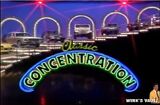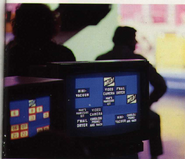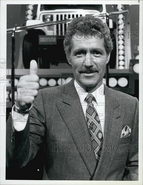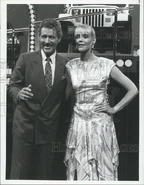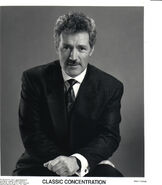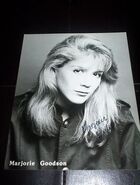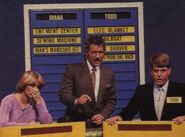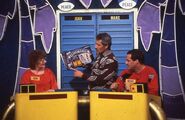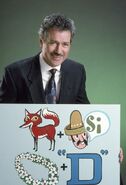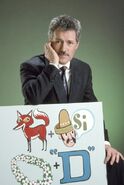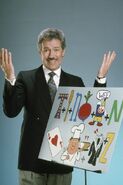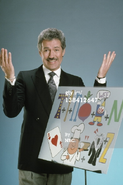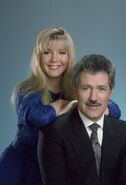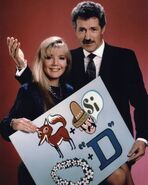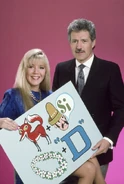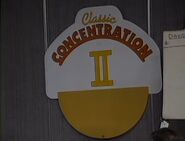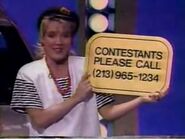| Aired | |
| Test Show, April 25, 1987 NBC Daytime, Monday, May 4, 1987 – Friday, September 20, 1991 | |
| Run time | |
| 30 Minutes | |
| Host | |
| Alex Trebek | |
| Models | |
| Diana Taylor (May 4-July 20, 1987) Marjorie Goodson-Cagle (July 22, 1987-September 20, 1991) | |
| Announcers | |
| Rich Jeffries (1987 Test Show) Gene Wood (1987-1991) Art James (sub 1991) | |
| Origination | |
| NBC Studio 3, Burbank, California | |
This is chronicling the successful 1987 version of Concentration called Classic Concentration.
Game format
Two contestants faced a computer animated game board consisting of 25 numbered squares. Behind those numbers were matching pairs of prizes. The hidden prizes cover up a rebus puzzle which the contestants try to solve. To start the game, two puzzle pieces were revealed at the start. Later shows gave no head starts. On a player's turn he/she picked off two numbers at a time. If the numbers he/she picked uncovered a match, he/she won the prize and revealed pieces of a puzzle. If he/she doesn't match, control of the board goes to the opponent.
Special Squares
Also hidden on the board were special squares that affected game play.
- Wild Card - This was a very special square which if uncovered, caused an automatic match. When one was uncovered, another number on the board revealed the natural match; so therefore three or more pieces were revealed instead of two. When the show started, there were three on the board and if two were found in the same turn, the contestant won a $500 cash bonus; if all three were found in the same turn, the contestant won a $1,000 cash bonus. Certain games in later shows had just one wild card on the board; so the $500/$1,000 cash bonuses did not apply.
- Take! - When matched, that gave the contestant in control the right to steal one of his/her opponents' prizes if he/she had any or save the "Take!" for a later time. It was absent for the first few months but then after November 11, 1987, the Take One Gift squares now called simply "Take!" returned. At first only the green cards were on the board, but later shows also featured red Take! cards. The Takes had to be matched by color.
- Cashpot - This premiered in 1989. When matched, this allowed contestants to win a mini cash jackpot which started at $500 and grew $100 for every day it's not won.
- 5 Bonus Car Seconds - Only shown in the second game, when if matched, the contestant had a chance to add five additional seconds to the clock in the bonus game.
The first player to solve the puzzle kept all the prizes & bonus cash and went on to play the bonus game for a new car.
Should time run out in the middle of the second game, the puzzle was revealed one square at a time and the first player to buzz-in with the correct solution was declared the winner. If the buzz-in played missed, the remainder of the puzzle was revealed and the opponent got a free guess.
Bonus Game
In the bonus round instead of 25 numbered squares, the winning contestant was faced with 15 numbered squares. Behind the numbers were eight brand new cars. Seven of them will match each other while one car will not match, this acted as a decoy to distract the contestant. The winning contestant's objective was to match as many cars as they can within the time limit; the time was 35 seconds plus 5 for every bonus round loss. If he/she can match all seven cars before time ran out, the winning contestant kept the last car matched.
Returning champions
In the beginning of the run, the player who solved the rebus went to the Winner's Circle while the loser was eliminated (except in cases of an interrupted game, when the losing player would return to play in the next match as the "challenger"). On July 4, 1988, the format was changed into a best-of-three match, with the first player to solve two rebuses winning the match and playing the bonus game. Unlike most game shows that tend to straddle when playing a best-of-three format, Classic Concentration had each match and bonus game fit into one complete show. The first game was split over the first two segments, with the second (and possibly) third game taking up the third segment. The bonus round was played during the fourth segment of the show.
From July 2, 1990 until the end of the run, contestants played the bonus game after solving a puzzle, and would be eliminated from competition after losing two games.
Audience Game
If there was time remaining during some shows, an audience member preselected before taping began played the bonus round for up to $500. Instead of the names of cars, dollar amounts of $5, $10, $15, $20, $25, $50, $75, and $100 were hidden behind the 15 numbers. The audience member was given 60 seconds and kept any amounts matched, which accumulated as they went along, or $500 for clearing the board. This segment was played at least twice.
Tournament of Champions
Starting in 1988 and continuing annually until the end of first-run episodes, there was a Tournament of Champions. Ten contestants who won the bonus round in the shortest amount of time were invited back to play for a more upscale car and an extra bonus prize -- depending on the year, either a trip around the world or $10,000 cash.
Two contestants compete for the same show, playing two front games. For the first show only, the winner played the bonus round with the clock counting up. If the contestant was able to clear the board within the time limit, their time became the new "base time" (e.g., if a contestant cleared the board in 29 seconds, all future contestants had to complete the round in less time to be eligible to win; the clock counting down in all other cases). At the end of the tournament, the contestant who completed the bonus round in the shortest time kept the car they nominally won, plus won the additional grand prize.
Personnel
- Host: Alex Trebek
- Announcer: Gene Wood
- Executive Producers: Chester Feldman, Howard Felsher
- Producer: Gabrielle Johnston
- Director: Marc Breslow
- Rebus Designs: Steve Ryan
- Graphic Artists: Bernard Schmittke, Vern Jorgensen, Carolyn Hughes, Suzannes Morales
- Set Designers – James Agazzi, Diane O’Connell, Molly Joseph, R. Brandt Daniels
- Music –Paul Epstein for Score Productions, Stanley Billts
Trivia
This show replaced the short-lived 1987 revival of Blockbusters hosted by Bill Rafferty four months later.
This was Trebek's second Goodson-produced game show that he hosted, his first was Double Dare (not to be confused with the popular Nickelodeon kids game show of the same name) in 1976 and his third (and final) one was the short-lived revival of To Tell the Truth in 1991.
In the first episode a contestant named David found three Wild Cards on the board.
The rainbow of cars graphic from the bonus round was also used on the Eubanks/Rafferty version of Card Sharks when a contestant wins a car game in the bonus round.
The panel flip sound from this version is used on many Saturday Night Live (or SNL for short) game show sketches as the ring-in sound. It was also heard on Trivia Trap and the 1989 version of Now You See It. The Face-Off buzzer sound from Family Feud was used in a Speed-Up round.
Reruns of the show continued to air on NBC until December 31, 1993.
The theme song from this series was originally used in the unsold 1985 Orson Bean hosted pilot of Concentration.
The test episode (taped on April 25, 1987) featured Rich Jeffries as the announcer, and some technical issues such as pieces of the puzzle not being properly aligned. A yellow border was around the puzzle in both rounds. The upper blue platform where the Contestants' podiums were had fuller edges that were cut off in the series. The Winner's Circle in the first game gave the player 45 seconds for the first try instead of 35. The logo was superimposed at the top of the screen before the "commercial break". The Mark Goodson Television Production logo scrolled upward. The end title logo was a little different and was right above the copyright credit. There was no second playing in the Winner's Circle round. Either there was a problem in the original transfer from analog to digital, or it was not taped. The lineup of cars was the same as on the first two weeks.
Merchandise
Main Article: Classic Concentration/Merchandise
Photos
Contestant Plug
Episode Status
The series is believed to be intact and reruns of the show currently air on the digital multicast network Buzzr.
Episode Guides
NOTE: All eighteen sections will be eventually completed. Winners are bolded.
Video

Classic Concentration II

Classic Concentration (March 7, 1990)

Classic Concentration - December 30, 1987

CLASSIC CONCENTRATION PROMO

Classic Concentration promo 1, 1987

Classic Concentration promo 2, 1987

Classic Concentration promo, 1988

NBC 4 Weeks Of Fun daytime promo

Classic Concentration promo, 1991

Go sit on a car, Marjorie!
See Also
Concentration (1973)
Concentration (1985 pilot)
Links
The NEW Classic Concentration Home Page
The Best of 80s & 90s Game Shows: Classic Concentration
(Classic) Concentration @ Pearson's Official Website (via Internet Archive)
A Blog about Classic Concentration @ Best of the 80s
